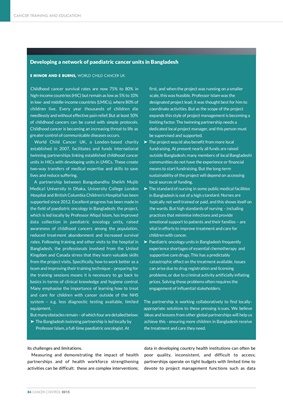
CANCER TRAINING AND EDUCATION
84 CANCER CONTROL 2015
Childhood cancer survival rates are now 75% to 80% in
high-income countries (HIC) but remain as low as 5% to 10%
in low- and middle-income countries (LMICs), where 80% of
children live. Every year thousands of children die
needlessly and without effective pain relief. But at least 50%
of childhood cancers can be cured with simple protocols.
Childhood cancer is becoming an increasing threat to life as
greater control of communicable diseases occurs.
World Child Cancer UK, a London-based charity
established in 2007, facilitates and funds international
twinning partnerships linking established childhood cancer
units in HICs with developing units in LMICs. These create
two-way transfers of medical expertise and skills to save
lives and reduce suffering.
A partnership between Bangabandhu Sheikh Mujib
Medical University in Dhaka, University College London
Hospital and British Columbia Children's Hospital has been
supported since 2012. Excellent progress has been made in
the field of paediatric oncology in Bangladesh; the project,
which is led locally by Professor Afiqul Islam, has improved
data collection in paediatric oncology units, raised
awareness of childhood cancers among the population,
reduced treatment abandonment and increased survival
rates. Following training and other visits to the hospital in
Bangladesh, the professionals involved from the United
Kingdom and Canada stress that they learn valuable skills
from the project visits. Specifically, how to work better as a
team and improving their training technique - preparing for
the training sessions means it is necessary to go back to
basics in terms of clinical knowledge and hygiene control.
Many emphasise the importance of learning how to treat
and care for children with cancer outside of the NHS
system - e.g. less diagnostic testing available, limited
equipment.
But many obstacles remain - of which four are detailed below:
‰ The Bangladesh twinning partnership is led locally by
Professor Islam, a full-time paediatric oncologist. At
first, and when the project was running on a smaller
scale, this was feasible. Professor Islam was the
designated project lead; it was thought best for him to
coordinate activities. But as the scope of the project
expands this style of project management is becoming a
limiting factor. The twinning partnership needs a
dedicated local project manager, and this person must
be supervised and supported.
‰ The project would also benefit from more local
fundraising. At present nearly all funds are raised
outside Bangladesh; many members of local Bangladeshi
communities do not have the experience or financial
means to start fundraising. But the long-term
sustainability of the project will depend on accessing
local sources of funding.
‰ The standard of nursing in some public medical facilities
in Bangladesh is not of a high standard. Nurses are
typically not well trained or paid, and this shows itself on
the wards. But high standards of nursing - including
practices that minimise infections and provide
emotional support to patients and their families - are
vital in efforts to improve treatment and care for
children with cancer.
‰ Paediatric oncology units in Bangladesh frequently
experience shortages of essential chemotherapy and
supportive care drugs. This has a predictably
catastrophic effect on the treatment available. Issues
can arise due to drug registration and licensing
problems, or due to criminal activity artificially inflating
prices. Solving these problems often requires the
engagement of influential stakeholders.
The partnership is working collaboratively to find locallyappropriate
solutions to these pressing issues. We believe
ideas and lessons from other global partnerships will help us
achieve this - ensuring more children in Bangladesh receive
the treatment and care they need.
Developing a network of paediatric cancer units in Bangladesh
E MINOR AND E BURNS, WORLD CHILD CANCER UK
its challenges and limitations.
Measuring and demonstrating the impact of health
partnerships and of health workforce strengthening
activities can be difficult: these are complex interventions;
data in developing country health institutions can often be
poor quality, inconsistent, and difficult to access;
partnerships operate on tight budgets with limited time to
devote to project management functions such as data